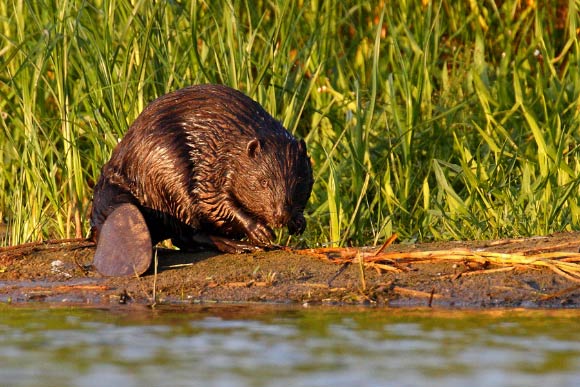George Zimmerman wants to become a lawyer to stop ‘miscarriage of justice.’
February 18, 2014
Is the EU ready for a common foreign policy?
February 19, 2014European beaver (Castor fiber) has been strongly affected by expanding human populations for many thousands of years, says a team of genetic scientists led by Prof Michi Hofreiter from the University of York, UK, and the University of Potsdam, Germany.

Eurasian beaver, Castor fiber, in the Tczew area, northern Poland. Image credit: Klaudiusz Muchowski / CC BY-SA 3.0.
Beavers have long been an important resource for human populations across the northern continents. Their fur is of exceptional quality, and has been a highly traded commodity. Beavers have also been hunted for meat and for castoreum – an anal gland secretion often used in traditional medicine.
Stone engravings at Lake Onega in northern Europe indicate that beavers played a role in ancient human societies from around 3,000-4,000 years ago.
After centuries of human hunting, the Eurasian beaver had disappeared from most of its original range by the end of the 19th century, with only an estimated 1,200 beavers remaining.
“Centuries of hunting, rather than changing climate conditions since the beginning of the Holocene (or recent) period, accounts for the lack of genetic diversity, as well as the geographic distribution of genetic diversity, seen in modern European beavers,” said Prof Hofreiter and his colleagues, who reported the results in an article in the journal Molecular Ecology.
Through DNA sequencing, they discovered that the Eurasian beaver can be divided into three distinct groups.
The two main ones are in western and eastern Europe, with a now extinct, and previously unknown, third group in the Danube basin. This population existed at least 6,000 years ago but went extinct during the transition to modern times.
In their study, Prof Hofreiter with co-authors examined DNA from 48 ancient beaver samples, ranging in age from several hundred to around 11,000 years old, and 152 modern DNA sequences.
“While beaver populations have been growing rapidly since the late 19th century when conservation efforts began, genetic diversity within modern beaver populations remains considerably reduced to what was present prior to the period of human hunting and habitat reduction. In addition, the rapid loss of diversity prior to conservation efforts appears to have established a very strong pattern for the geographic distribution of genetic diversity among present-day beaver populations,” Prof Hofreiter said.
“We found that overall there was more genetic diversity in the past. Apparently, already in ancient times an ancient contact zone existed between the eastern and western populations of beavers in the Oder River area. This is close to a present-day contact zone in Germany and Poland,” said first author Dr Susanne Horn from the Max Planck Institute for Evolutionary Anthropology in Leipzig, Germany.
“The present-day contact zone was assisted by conservation management and members of the eastern and western population groups meet there today as they did in the past. This suggests that conservation management may, in the long run, help to restore the pre-human impact population structure of threatened species,” Prof Hofreiter said.
______
Susanne Horn et al. Ancient mitochondrial DNA and the genetic history of Eurasian beaver (Castor fiber) in Europe. Molecular Ecology, published online February 12, 2004; doi: 10.1111/mec.12691

